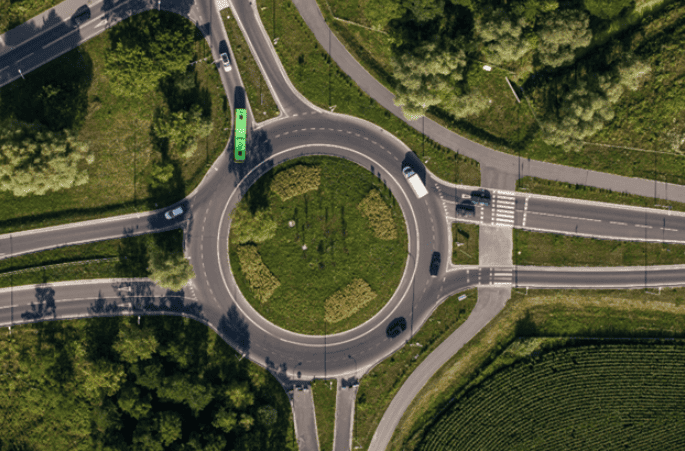- Need Any Help: +1 647-760-5505 or
- info@trubicars.ca
Although you may not see many, roundabouts could be in your community. Some communities are adding more roundabouts in areas where traffic-lighted intersections or stop sign intersections once were. Learning how to use a roundabout can be done through the aid of professional driving instructors found at Trubicars.
If you believe roundabouts are new, they aren’t. They have been around for years. The first roundabouts in North America were constructed over 100 years ago and were first in Europe in the 1800s as traffic circles. Just because they may look different from regular intersections doesn’t mean they are difficult to use. It’s all about understanding them.
A few of the changes we make for drivers within our communities can seem overwhelming for some people, but all it means is that we have to relearn how to drive in certain areas. Although we know roundabouts do not look the same as regular intersections, they also need to be treated differently.
Understanding the rules of using roundabouts will help to make the transition easier. Roundabouts are safer for drivers to travel through compared to traveling through controlled intersections such as traffic lights or stop signs.

One of the simple rules for roundabouts is to never travel beside another vehicle when you enter. If the other driver chooses the wrong lane or begins to drift into your lane as they move throughout the roundabout, it would be a good idea to let the driver next to you pass before you enter the roundabout or get slightly ahead of that driver.
This adjustment will help the other driver exit the roundabout and onto the new road in a much easier fashion. This adjustment is helpful when large trucks are entering the roundabout. They will often go into both lanes at some point because of the size of the vehicle.
To help make driving through a roundabout a smooth experience, choose the correct lane you need before you reach the roundabout. This is important because lane changes are prohibited and dangerous while traveling in the roundabout. Information signs are visible before you reach the roundabout to help you decide which lane to take prior to reaching the roundabout. Since you know they are there, all you have to do is look for them.
So, which lane do you use? Use the left lane to go around most of the roundabout or if you intend to go straight after exiting the roundabout. You should use the right lane to turn right at the first exit or if you decide to continue straight after the roundabout. You should not be in the right lane if you intend to turn left, as lane changes in a roundabout are illegal.
If you see a cyclist, they will typically keep to the centre of the appropriate lane or perhaps dismount and use the roundabout like a pedestrian. If you are traveling behind a cyclist, ensure you give them enough space in front of your vehicle as you would anywhere else until you exit the roundabout.
One of the advantages of using roundabouts is there is typically less waiting for openings to appear to make it across the path of traffic while leaving the roundabouts compared to waiting to turn left at a traffic light. One of the most dangerous actions many drivers will do is to turn left at a traffic light. The reason for this is that they can be injured by another vehicle hitting their vehicle while they are making that turn. The risk of serious injury or being involved in a collision can be avoided at roundabouts.
If a collision happens in a roundabout, it would happen at a lower speed compared to a collision at traffic lights. The reason for this is that drivers will have to reduce their entrance speed in most cases before entering the roundabout, and if there is any possible injury, it could almost be avoided in a roundabout. It is rare for vehicles to stop in a roundabout, so it helps keep traffic moving, which helps avoid delays in getting to your destination.
When you approach the roundabout, check for any vehicles already in the roundabout to your left and anyone waiting to enter it to your left. You should also check for any cyclists since they could be in your path in the roundabout as you enter it. Anyone currently in the roundabout should be given the right-of-way.
Yield signs at the entrance of roundabouts mean you may need to adjust your speed or stop at the yield sign to wait your turn if necessary.
If you are wondering, there is no need to place your turn signal on as you enter the roundabout since you are following the direction of the road. Signaling to leave the roundabout is required so as to let the driver who is approaching the roundabout know that you leave the roundabout at that first exit. This will inform them they can enter the roundabout.
Using a right turn signal is required when exiting the roundabout, even if you are going slightly around the roundabout, or straight as it may appear. Some people may feel a left turn signal is needed since that is what is used at a traffic-lighted or stop-sign intersection. Placing a left turn signal on will only confuse other drivers and could cause a delay in their entering the roundabout.
Although roundabouts are a special kind of intersection, you are still required to watch for pedestrians as you approach the roundabout and when you approach your intended exit. Pedestrians should do their best to wait for a gap in traffic before crossing the road at the roundabout if possible, although many pedestrians may walk like they would at other intersections.
The more you drive through your local roundabouts, the more you will appreciate how smoothly roundabouts are designed and how safe they are. Practice driving through them so you feel comfortable and confident with them. Having professional lessons from a driving school from Trubicars can help the learning process become very smooth. Contact Trubicars today to get started!

 March 9, 2025 by
March 9, 2025 by Trubicars
Trubicars
 January 16, 2025 by
January 16, 2025 by Trubicars
Trubicars
 January 16, 2025 by
January 16, 2025 by Trubicars
Trubicars
Once you acquire the knowledge provided in
those tests, you are ready to pass the test,
for the first time.
